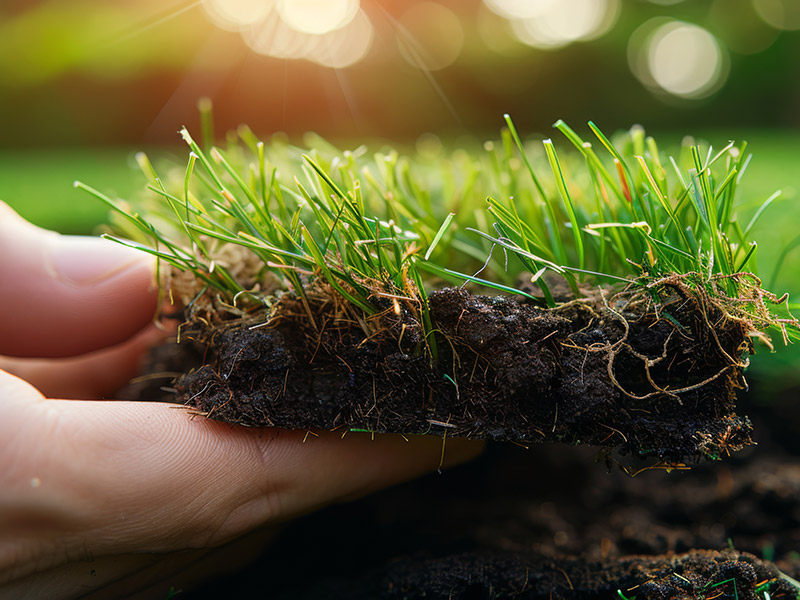The Importance of Calcium for Turfgrass Health and Maintenance
Introduction
Calcium is an essential nutrient for the growth, health, and sustainability of turfgrass. While nitrogen, phosphorus, and potassium receive the most attention in turf management, calcium plays a critical role in improving soil structure, strengthening plant cell walls, and facilitating various physiological processes. Without adequate calcium, turfgrass can suffer from poor root development, disease susceptibility, and reduced resilience to environmental stress. This article explores the importance of calcium for turfgrass, how it affects soil health, and best practices for calcium supplementation in turf management.
The Role of Calcium in Turfgrass Growth
Calcium is vital for various biological functions in turfgrass, including:
- Cell Wall Development: Calcium is a key component of plant cell walls, contributing to cell rigidity and overall plant strength. It ensures that turfgrass remains upright and resilient to physical stress.
- Root Development: Calcium enhances root elongation and strength, allowing the grass to absorb water and nutrients more effectively. Strong roots contribute to drought resistance and better anchoring of the grass.
- Enzyme Activation: Calcium plays a role in activating enzymes that support nutrient uptake and metabolic processes in turfgrass.
- Nutrient Transport and Retention: It helps in the transport of other essential nutrients, ensuring that grass efficiently utilizes applied fertilizers.
- Disease Resistance: Adequate calcium levels improve turfgrass resistance to fungal diseases, such as Pythium root rot and brown patch, by strengthening cell walls and reducing pathogen penetration.
- Alleviation of Soil Compaction: Calcium improves soil structure by aiding in the aggregation of soil particles, reducing compaction, and improving aeration.
Calcium and Soil Structure
One of the most significant ways calcium influences turfgrass health is through its impact on soil composition. Calcium contributes to soil structure by encouraging flocculation, a process where soil particles clump together to create pore spaces. These spaces facilitate water infiltration, air circulation, and root penetration.
Calcium Deficiency
Calcium deficiency is commonly found in degraded, acidic, or sandy soils and through excessive use of fertilisers (build-up of NH4+, CI- and Na+). For every Kg of N applied to a soil a Kg of Calcium is removed. pH is not an indication of calcium availability to the turf
Symptoms of Calcium Deficiency in Turfgrass
- Calcium deficiency in turfgrass can lead to a variety of issues, including:
- Stunted root growth and weak grass establishment.
- Increased vulnerability to diseases.
- Poor response to fertilisers due to inefficient nutrient uptake.
- Yellowing or thinning of grass blades.
- Increased soil compaction, leading to poor drainage and reduced oxygen availability to roots.
Symptoms of Calcium for Turfgrass
Several materials can be used to supply calcium to turfgrass, including:
- Lime (Calcium Carbonate – CaCO3): Often used to raise soil pH while providing calcium.
- Gypsum (Calcium Sulfate – CaSO4): Supplies calcium without affecting soil pH, making it ideal for alkaline soils.
- Calcium Nitrate (Ca(NO3)2): Provides both calcium and nitrogen, promoting rapid plant uptake and growth.
- Bone Meal and Organic Amendments: Natural sources of calcium that provide slow-release benefits to the soil.
- Calcium Phosphite (CaHPO3) which provides efficient foliar uptake
Best Practices for Calcium Application
To ensure adequate calcium levels in turfgrass, consider the following strategies:
- Soil Testing: Regular soil tests should be conducted to determine calcium levels and soil pH before applying amendments.
- Proper Application Timing: Calcium amendments are best applied during active turfgrass growth seasons to maximize nutrient uptake.
- Balanced Fertilisation: Excessive nitrogen or potassium can interfere with calcium uptake. A balanced fertilisation plan should be implemented.
- Adequate Irrigation: Water helps move calcium into the soil and roots, ensuring proper absorption by turfgrass.
Conclusion
Calcium is an often overlooked but essential nutrient for turfgrass health. It plays a crucial role in plant structure, root development, soil conditioning, and disease resistance. By maintaining optimal calcium levels through soil testing and appropriate amendments, turf managers and homeowners can enhance the resilience and vigour of their turfgrass, leading to a healthier and more sustainable lawn.

